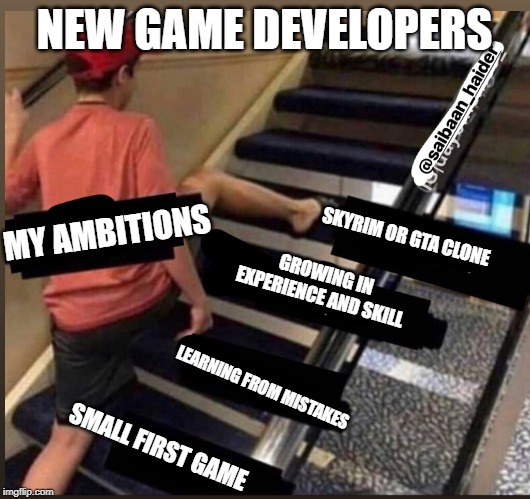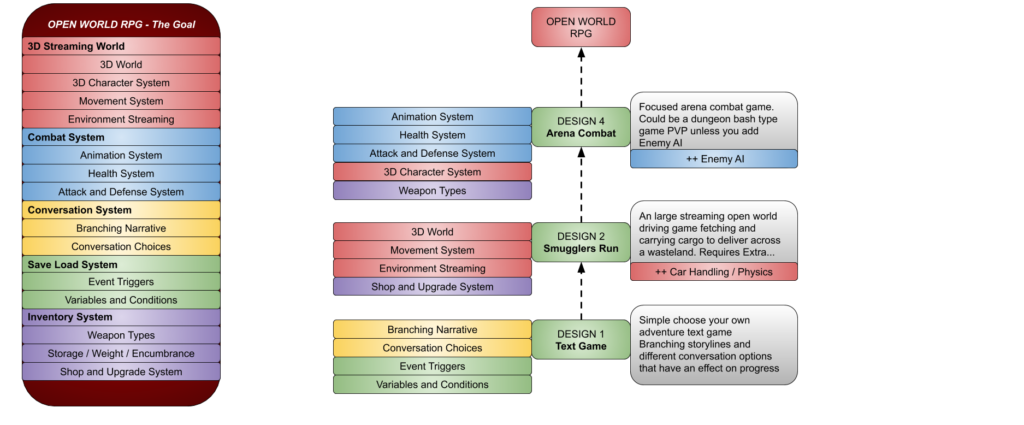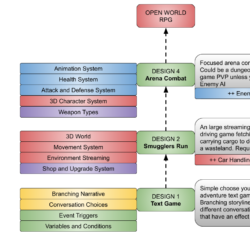This article will describe how to plan a long term objective to create those grand, ambitious, complex game designs you dream of making. If you have an idea which you truly think is worth pursuing but the sheer size and scale scare you from starting it then I will describe the tricks that professionals use to reach their goals.

I’m going to make some assumptions for this article…
- That you want to create a successful game development company
- That you want your company to make more than one game
- That you would like your games to earn you enough money to live and make another game
- That you are starting pretty much from scratch without vast sums of cash to fund your enterprise (that comes later!)
Need some tips to choose your company name? Have a look to our 7 Professional Steps on Creating Company Names (Which also apply to Naming Games)
By no fault of their own new developers starting a games company generally think only about their first game idea and this excites them. They add more features as the idea grows and forms until they are happy it has become a fully formed project. However, the mistake I often see is that new developers try to be too ambitious when designing their first game.

The problem with large ambitious games is their complexity and scale. There is nothing worse than realizing halfway through a project that you have bitten off more than you can chew and feeling like you will never finish. This soul-crushing realization often results in projects being scrapped or left to collect dust. A half-finished project will earn you NOTHING. It’s lost time and lost potential revenue.

Small indie start-up companies to experienced game studios should all be thinking about their long term game catalog and the technology they will build along the way. It’s no coincidence that some of the most successful game studios have specialized in making a certain type of game. Not only to specialize their skillset but also to specialize their technology which makes building the next game much MUCH easier (and cheaper) than starting from scratch.
Taking this principle of building a solid foundation of features over time and releasing saleable games along the way is the key to making your dream game without going insane or bankrupt. So how do you plan your route from nothing to being able to make your dream game a reality?
- First, think of every feature or system that will be required for your dream game
- You should have a good idea of what your game is
- A fleshed-out concept or design document will eliminate vagueness or unknown aspects
- List these features with a “gut feeling” for time/effort
– This is a simple sizing technique used in some Agile methodologies common in game development- It doesn’t have to be totally accurate, just a guideline for decisions
- If you have other team members get them to size each feature as well
- If you have huge differences ask why yours varies so much from theirs, they may have thought of something you haven’t which affects their opinions
- If not, ask friends or skilled developers to have a quick sanity pass over your projections, they might add something you never knew you needed
- Now think of each of these features like a Lego brick and try to arrange them into groups which would make a game you could build and sell

The art of the next step is how to create game designs from the features you have listed and grouped into something that could be sold on the market and stand a chance of doing pretty well. Professional game designers are specialists at thinking within constraints so this exercise should be a good test for them. Newer designers may find this step challenging to not keep adding features to an idea to make it feel complete (and thus we get back to our original problem of an overly big demanding first project).
Instead, if that open-world RPG is your heart’s desire, try working towards it in steps. Break the game down into components that you need.
- Combat system
- Inventory System
- Conversation System
- Open World Environment
Now how could you build your technology and also release something that could earn you money while you continue to develop everything you need for that RPG you dream of making?
- Open World – Build a simple racing game to develop a streaming world
- Inventory and Upgrade System – A collectible game
- Conversation System – Text-based narrative game
- Combat System – Simple 3D arena fighting game
By making each of these components a game in their own right you are building the technology you require. The more reusable technology you build the faster you can get a bigger game to market and earn some money. Keeping money flowing into the company means you can keep making games.
My advice would be to take the total amount of effort required and divide it up into chunks with the smallest chunk first and the largest effort last. A phrase that is often used for risk and development is to “Fail fast”. It’s ok to get things wrong, but if you can do it quickly you can learn and progress much quicker. Thus you are far more productive if you realize something is a mistake early than trying to make it work and failing much later.
Splitting your effort and time into small chunks means you can reevaluate if something isn’t working. It also means that your skills and abilities will grow as you complete games, so waste little effort on your first projects which probably won’t set the world on fire and give you a much better chance of success for your later more important projects.
- First Project 20%
- Second Project 30%
- Third Project 50%
- Dream Game is feature complete now just make it awesome!
I can’t stress enough how much the human psyche works on small victories especially when it perceives an insurmountable task ahead of it. There’s a reason Microsoft added gamer points to achievements. That little dopamine rush when you get one gives you a pleasant sense of satisfaction. Game development can be a long, hard road and setting achievable micro objectives to break down a seemingly huge task gives you a sense of progression as you chip away at it.
Side Note About Investors
One last point I wanted to raise before finishing this article is to mention funding and potential investment. At some point, you might need to raise funds so you can finish your first second or even third game, even before you’ve managed to build your dream game.
When this happens, investors will want to take a look at not only your current game demo but also your business plan.
Part of the business plan should include a road map for the company. Its projects sales and growth. Now if you have followed the steps I’ve discussed in this article and can show critical thinking about building technology and showing an awareness of growth in a sensible manageable way, you will be speaking an investor’s language. You are demonstrating that you are thinking about risks and minimizing their chance of making a bad investment. The result will be happy smiles and handshakes rather than awkward questions you don’t have answers to.
The Benefits of a Long Term Plan
If you want a successful games company you need to think long term as well as short term. If you want people to back more than just one game you need to think about what comes next. If you have a long term objective then you will already know what you should be moving on to.
Here’s an example. You finish your first game and then what? Suddenly trying to think of the next great hit?
I guarantee that as soon as your game launches you will be busy supporting the launch, answering emails to websites and trying to secure as much coverage as possible so your game sells. What is the rest of your team going to do while your busy doing PR and marketing?
Coders and artists sat around not making anything are expensive, a money drain if they are taking a wage, a time killer if they aren’t. But now you know where you are heading and what needs to come next, you can already get the rest of your team working on the next game features while you support your new release.
I hope you find this article useful on your path to great things in the games industry.
Bob Hands – Sanity Check
Further reading/content
Failing to Fail: The Spiderweb Software Way
How to Survive in Gamedev for Eleven Years Without a Hit




